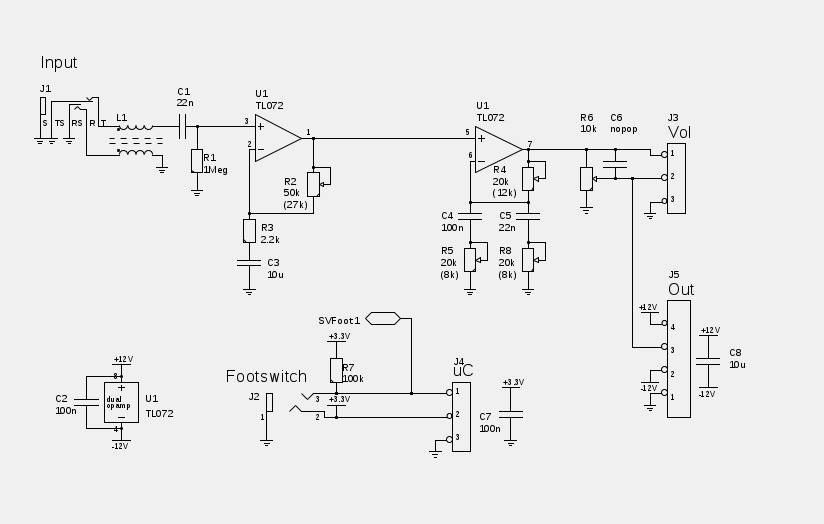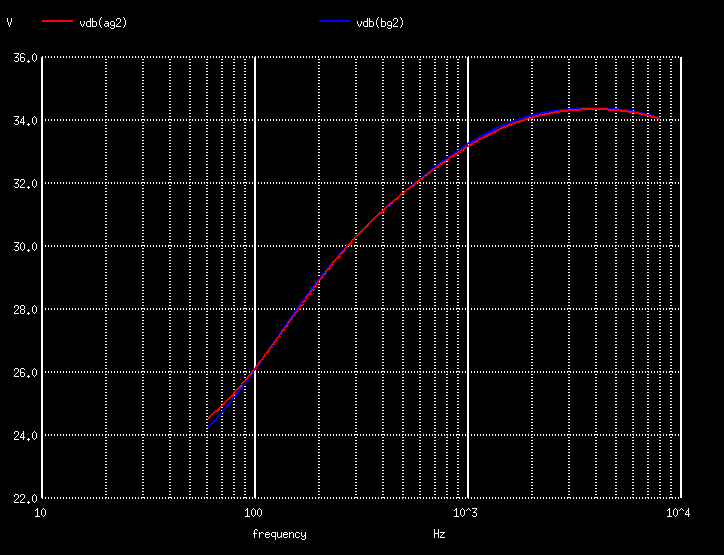I have a premade faceplate for my amp build, it's a two vertical input plate from ceriatone. I'm not currently planning to ever use both inputs. Kicking around for ideas for the 2nd hole. I could go ahead an make a 2nd input and never use it. Or I could do something else with it. I'd kinda sorta like to keep it more or less related to its functional grouping. (Ie, A knob in the "low sensitivity" hole is not where you'd expect to find the power scaling control)
My input jacks are on their on mini board, buffered right at the jack with a TL072 and it's making up the gain and pre-emphasis that would normally be done by V1a and it's tone shaping circuits. I'm already planning to use a few trimpots on the board for trimming out the gain, amount of preemphasis and the rolloff frequency. I've redesigned my input circuit a few times to make it more tweakable, and it's a lot better (at least in terms of logical separation) than the first passes, but the controls are still rather interactive, and don't lend themselves to frobbing, with the exception of the gain, but I already have a volume knob.

Posting the schematic in case it suggests features. Some kind of mid boost/fat control seems like an obvious suggestion. (I tried and tried, but couldn't match the rolloff in just the feedback loop using just one eq. The two get reasonably close.)
R2 controls gain
R4,R5,R8 control the amount of boost in the preemphasis, and the frequency, but are highly interactive. Changing frequency has major overall gain implications. If changing the rolloff point for preemphasis was a one knob deal, I almost think it'd be more useful to control the shift points on the pre-eq than another volume/boost. I mean, a master volume amp already has two knobs dedicated to "MORE DISTORTION" it's not like it needs another. I'm currently leaning towards trying to toss a notch into that feedback loop for a boost, but if anyone has suggestions on separating the frequency and gain of the 2nd stage, I'm all ears. (I'm thinking it needs to be inverting to do so.)
Here's how it behaves (Red is the original circuit. Blue is this one. Both are viewed at what would be the V1b grid)

My input jacks are on their on mini board, buffered right at the jack with a TL072 and it's making up the gain and pre-emphasis that would normally be done by V1a and it's tone shaping circuits. I'm already planning to use a few trimpots on the board for trimming out the gain, amount of preemphasis and the rolloff frequency. I've redesigned my input circuit a few times to make it more tweakable, and it's a lot better (at least in terms of logical separation) than the first passes, but the controls are still rather interactive, and don't lend themselves to frobbing, with the exception of the gain, but I already have a volume knob.

Posting the schematic in case it suggests features. Some kind of mid boost/fat control seems like an obvious suggestion. (I tried and tried, but couldn't match the rolloff in just the feedback loop using just one eq. The two get reasonably close.)
R2 controls gain
R4,R5,R8 control the amount of boost in the preemphasis, and the frequency, but are highly interactive. Changing frequency has major overall gain implications. If changing the rolloff point for preemphasis was a one knob deal, I almost think it'd be more useful to control the shift points on the pre-eq than another volume/boost. I mean, a master volume amp already has two knobs dedicated to "MORE DISTORTION" it's not like it needs another. I'm currently leaning towards trying to toss a notch into that feedback loop for a boost, but if anyone has suggestions on separating the frequency and gain of the 2nd stage, I'm all ears. (I'm thinking it needs to be inverting to do so.)
Here's how it behaves (Red is the original circuit. Blue is this one. Both are viewed at what would be the V1b grid)


Comment